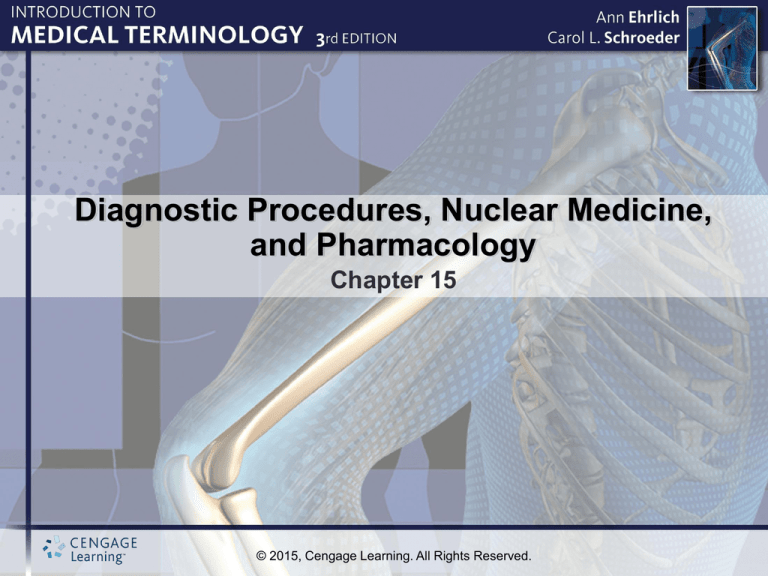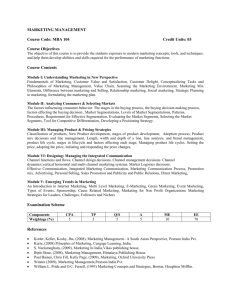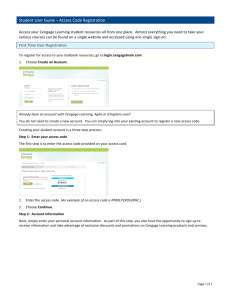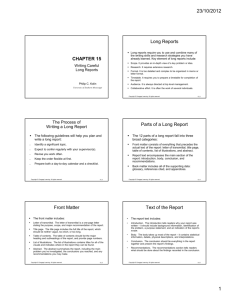
Diagnostic Procedures, Nuclear Medicine,
and Pharmacology
Chapter 15
© 2015, Cengage Learning. All Rights Reserved.
Overview of Diagnostic Procedures,
Nuclear Medicine, and Pharmacology
© 2015, Cengage Learning. All Rights Reserved.
Basic Diagnostic Procedures
•
•
•
•
Vital signs
Auscultation
Palpation and percussion
Basic examination instruments
© 2015, Cengage Learning. All Rights Reserved.
Vital Signs
• Temperature: average normal is 98.6°F
(Fahrenheit) or 37.0°C (Celsius)
• Pulse: rhythmic pressure against walls of an
artery caused by beating of heart
• Respiration: number of complete breaths
per minute
• Blood pressure: force of blood against walls
of arteries
© 2015, Cengage Learning. All Rights Reserved.
© Cengage Learning
Pulse Points of the Body
© 2015, Cengage Learning. All Rights Reserved.
Auscultation
• Auscultation
– Listening for sounds within the body
– Performed through a stethoscope
© 2015, Cengage Learning. All Rights Reserved.
Palpation and Percussion
• Palpation
– examiner’s hands feel texture, size, consistency,
and location of body parts
• Percussion
– determines density of a body part by sound
produced by tapping surface with fingers
© 2015, Cengage Learning. All Rights Reserved.
Basic Examination Instruments
• Ophthalmoscope: to examine interior of eye
• Otoscope: to examine external ear canal and
tympanic membrane
• Speculum: to enlarge opening of a canal or
cavity for inspection of its interior
• Stethoscope: to listen to sounds within the body
© 2015, Cengage Learning. All Rights Reserved.
Examination Positions
•
•
•
•
Recumbent positions
Sims’ position
Knee-chest position
Lithotomy position
© 2015, Cengage Learning. All Rights Reserved.
Recumbent Positions
• Horizontal recumbent position
– also known as supine position
– patient is lying on the back, face up
– used for examination and treatment of anterior
surface of the body and for x-rays
• Dorsal recumbent position
– patient lying on the back, face up, with the
knees bent
– used for examination and treatment of the
abdominal area and for vaginal or rectal exams
(continues)
© 2015, Cengage Learning. All Rights Reserved.
Recumbent Positions
• Lithotomy position
– patient lying on back, face up, with the feet and
legs raised and supported in stirrups
– used for vaginal and rectal examinations and
during childbirth
(continues)
© 2015, Cengage Learning. All Rights Reserved.
Recumbent Positions
• Prone position – patient lying on abdomen,
face down
• Sims’ position – patient lying on left side with
right knee and thigh drawn up with left arm
placed along back
• Knee-chest position – patient lying face down
with hips bent so knees and chest rest on table
© 2015, Cengage Learning. All Rights Reserved.
Laboratory Tests
• Blood tests
• Urinalysis
© 2015, Cengage Learning. All Rights Reserved.
Endoscopy
• Visual examination
• Endoscopic surgery
© 2015, Cengage Learning. All Rights Reserved.
Centesis
• Centesis: a surgical puncture to remove excess
fluid or to remove fluid for diagnostic purposes
• Used alone as a noun, or as a suffix in
conjunction with the combining form, describing
the body part being treated
(continues)
© 2015, Cengage Learning. All Rights Reserved.
Centesis
• Examples of centesis
–
–
–
–
abdominocentesis
arthrocentesis
cardiocentesis
pericardiocentesis
© 2015, Cengage Learning. All Rights Reserved.
Imaging Techniques
•
•
•
•
•
Radiography (x-ray)
Computerized tomography (CT)
Magnetic resonance imaging (MRI)
Fluoroscopy
Diagnostic ultrasound
© 2015, Cengage Learning. All Rights Reserved.
Nuclear Medicine
• Utilizes radioactive substances for both
diagnosis and treatment purposes.
© 2015, Cengage Learning. All Rights Reserved.
Radiographic Projections
and Positioning
• Projections
• Positioning
• Basic radiographic projections
© 2015, Cengage Learning. All Rights Reserved.
Terms Related to Pharmacology
•
•
•
•
•
Addiction
Adverse drug reaction (side effect)
Compliance
Contraindication
Drug interaction
(continues)
© 2015, Cengage Learning. All Rights Reserved.
Terms Related to Pharmacology
•
•
•
•
•
Palliative
Paradoxical drug reaction
Placebo
Idiosyncratic reaction
Potentiation (synergism)
© 2015, Cengage Learning. All Rights Reserved.
Key Word Parts and Definitions
• albumin/o
– albumin, protein
• calc/i
– calcium, lime, the heel
• -centesis
– surgical puncture to remove fluid
• creatin/o
– creatinine
(continues)
© 2015, Cengage Learning. All Rights Reserved.
Key Word Parts and Definitions
• glycos/o
– glucose, sugar
• -graphy
– the process of producing a picture or record
• hemat/o
– blood, relating to the blood
• lapar/o
– abdomen, abdominal wall
(continues)
© 2015, Cengage Learning. All Rights Reserved.
Key Word Parts and Definitions
• -otomy
– cutting, surgical incision
• phleb/o
– vein
• radi/o
– radiation, x-rays
• -scope
– instrument for visual examination
(continues)
© 2015, Cengage Learning. All Rights Reserved.
Key Word Parts and Definitions
• -scopy
– visual examination
• son/o
– sound
• -uria
– urination, urine
© 2015, Cengage Learning. All Rights Reserved.
Questions
© 2015, Cengage Learning. All Rights Reserved.
Question
In Sim’s position, which is used for examining
the rectal area, the patient is lying:
a. face down
b. on the left side with the right knee drawn up
c. on the back with the knees up
© 2015, Cengage Learning. All Rights Reserved.
Question
A lipid panel measures the ability of the liver to
secrete bilirubin into the bile.
True or False?
© 2015, Cengage Learning. All Rights Reserved.
Question
Which of these operations cannot be performed
using laparoscopic surgery?
a. appendectomy
b. cholecystectomy
c. cesarean section
© 2015, Cengage Learning. All Rights Reserved.
Question
Elephants have an average pulse of 27, and for
canaries the average is 1,000. What is the
average pulse for human beings?
a. 90
b. 120
c. 65
© 2015, Cengage Learning. All Rights Reserved.



